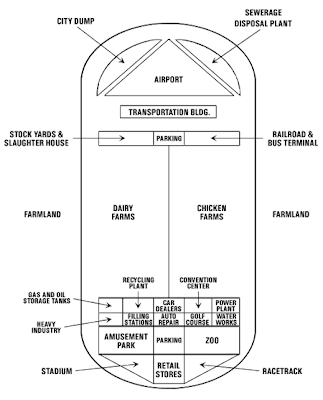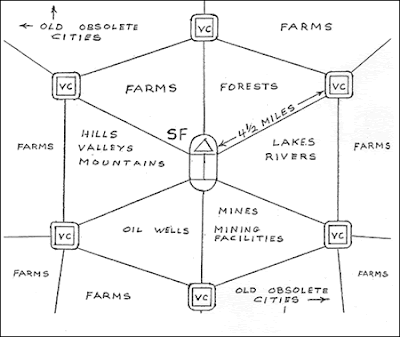There are many diverse versions of utopia that have been proposed over the years… from Wright’s Broadacre City, Howards Garden Cities, Callenbach’s Ecotopia, Soleri’s Arcosanti and Corbu’s La Ville Radieuse (to name a few) – a long history of attempts to synthesize urban perfection have been attempted. Most of these ideas are either merely thought-exercises or partially realized dreams, but provide a powerful counterpoint to our realities of urbanism. If we can think of perfection – how do we approach what we do in terms more resolved that mere utility?
:: image via Victory Cities
A recent post from Kosmograd enlightened me to another utopian vision that I’d yet discovered, that of Victory Cities. A project of Orville Simpson II, spanning a literally a lifetime of work – Victory City™ is either another addition in the utopian collection or the ramblings of a mad man without the good sense to let an idea go. You decide.

:: image via Victory Cities
Built in the countryside outside Dayton, Ohio, these ‘communities’ would be able to house 332,000 residents. The above graphic and map below show the general layout of the Victory City™. Kosmograd adds Simpson’s dilemma: “Starting with a childhood vision in 1936, and with no formal architectural or town planning training, Orville has been creating blueprints, drawings and residents manuals for his revolutionary, prototype community since 1960, He plans to build the first one just outside Dayton, Ohio, but is having problems finding the $100 million of private investment he feels he needs to create a development corporation.”

:: image via Victory Cities
Simpson is one of those central figures that seem to be common in most utopian visions. While some high-profile architects (mentioned above) had the latitude and reputation to postulate… it was a little more difficult for a 13 year old. From Victory Cities: “Afraid of being ridiculed, Mr. Simpson kept his ideas about designing and building the City of the Future to himself … a secret vision he held in his mind for approximately 24 years… It wasn’t until 1960 — after he had embarked on a lucrative career in real estate investing and apartment building management — that Mr. Simpson decided to make his ideas about Victory City™ known to the general public. Though not formally trained in graphic design or architecture, Mr. Simpson began sketching the entire Victory City model, building by building, with painstaking detail and vibrant color.”

:: image via Kosmograd
The goal is to build a Victory City™ outside of Dayton – so if you have an extra 100 million to chip in, shoot Simpson an email… There are many images that have been produced over the years – check out the tour here for a comprehensive view. A few to entice you into grabbing your checkbook:

:: images via Victory Cities
Food is a big part of the proposal, and much thought has been paid to growing, transporting, and feeding residents – sort of cohousing on a huge scale: “Every day, fresh produce, fish and chicken would be brought to the kitchens from the greenhouses, fish farm and poultry center. This would eliminate the need for canning, freezing, preservatives, artificial flavors, and all the other “junk” currently used in food production. All food would be cooked and eaten the same day it is brought in … Also eliminated would be the need for food processing plants, food storage warehouses, and food trucking and delivery cross-country. In addition, grocery stores would become a thing of the past, as well as most kitchen equipment and food storage in residential apartments.”

:: image via Victory Cities
All in all, there’s a compelling qualities to the graphics – sort of a visionary naivety and an illustrative technique of a first year architecture studio, where people are still learning their chops regarding. For something of this scope and scale – painting a vision in ways that are accessible and compelling to potential investors would seem the most important goal… In the level of marketing graphics, Simpson has a few more refined graphics, such as this one: “…conceived and drawn by fifth-year architectural student, Tom Sheehan, who has since graduated from the University of Cincinnati.”

:: image via Victory Cities
Although it still seems a bit fuzzy and vague – sort of, well, utopian. Lots of big picture visions and small-scale details that make a point, but perhaps remain unresolved or unattainable. Kosmograd asks some pointed questions at the overall social structure that has been proposed: “How will Victory Cities, with their radical social model, and built form, deal with the rest of the world. Would outsiders be allowed in, and would VC citizens be allowed out? In keeping everything together in a city-state mega-block, citizens’ relationship with the outside world is fractured, except for the sanitised exterior landscape – a hexagonal arrangement of lakes, forests, farms, hills, mines and oil wells around a Separate Facilities mega-plex holding an eclectic mix of functions including an airport, a race track, car dealerships and chicken farms.”
A diagram of the Separate Facilities (SF) mega-plex is found below:

:: image via Kosmograd
And its context in a larger area surrounding the SF, which starts to mimick the radial spoke-and-axle pattern of the Garden Cities, interwoven with natural resource and agricultural lands. I do like the reference to ‘old, obsolete cities.” Those urban ruins we keep talking about.

:: image via Kosmograd
Like many utopias there are many threads that inform, and can make more viable, the actual placemaking of cities… what can we learn from this and other utopian proposals that could help us in more broad scale planning efforts. The idea of self-sufficiency, for instance, is a powerful idea, although the rigid systematic approach is a bit to logistically challenging to acheive at this scale. A more appropriate solution would be to allow for areas for people to grow food locally, encourage small scale processing, and seasonal availability. By articulating some of these positive points and folding them into realistic proposals, we may not obtain utopia, but perhaps a more well-rounded approach to sustainable urbanism. Rather than a large scale Victory City, perhaps an accumulation of small wins would give us better urban areas.

:: image via Kosmograd

hmmm… this looks suspiciously like the Pruitt-Igoe development.
interestingly enough, a development also marketed to officials as a practical utopia.
great post!
It’s amazing how many planners and architects thought the utopias had to be a perfect symmetrical design.
Tony. I was not familiar with the Pruitt-Igoe development, but after a quick search I agree… I think a good number of those ‘urban renewal’ developments may have been envisioned as utopias of some sort or the other. Perhaps a lesson is that manufactured communities often lack in humanity – even with what seems like a rational approach to development. A short 20 year lifespan of the Pruitt-Igoe is a good indication of it’s immediate failure.
BC Planning: Good point. Is there some sort of throwback to the City Beautiful or other monumental city planning movements that seems more utopian than a real community that is messy and organic and real… one to ponder in the utopian discussions…
Cool